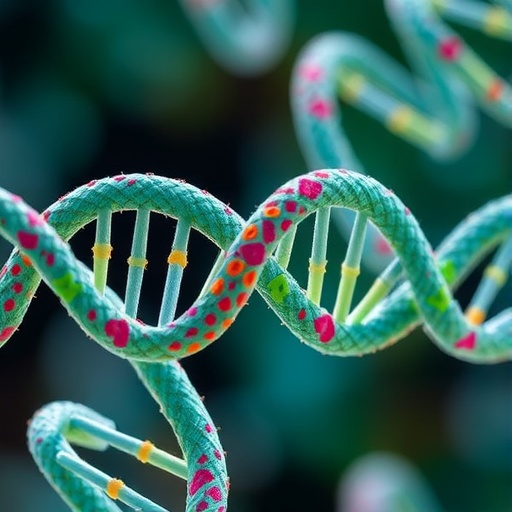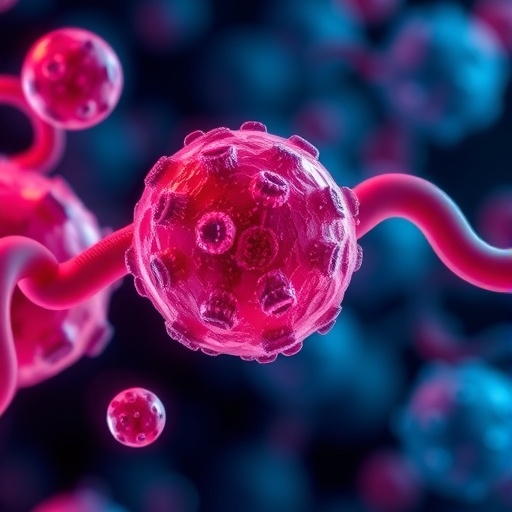Transcription is a vital cellular process orchestrated by RNA polymerase II (Pol II), enabling the expression of genes that drive both normal cell function and organismal development. However, the Poly II machinery is not immune to obstacles; external and internal factors can inflict DNA damage that stalls transcription, creating significant biological challenges. When the DNA strands are compromised, transcription-blocking lesions emerge, which can frustrate Pol II’s relentless journey along the DNA template. Such disruptions can trigger transcription stress, inducing a cascade of cellular dysfunction that has been linked to neurodegenerative diseases and aging processes.
Recent research has illuminated the mechanisms through which cells recognize and respond to DNA lesions that impede Pol II elongation. This recognition is crucial for maintaining the integrity of genetic information and ensuring proper cellular function. One of the most interesting mechanisms involves the transcription-coupled nucleotide excision repair (TC-NER) pathway, a complex but elegant system that serves to both recognize and repair lesions directly in the context of transcription. In essence, TC-NER represents a sophisticated alliance between DNA repair and transcriptional machinery, highlighting how cellular processes can work in concert to address the vulnerabilities of the genome.
One of the fundamental aspects of TC-NER is its ability to detect the presence of transcription-blocking lesions. This step is key because without it, damage could accumulate and result in profound consequences for cellular health. The structural biology of TC-NER has revealed intricate details about how it operates—specifically, how key proteins interact with stalled Pol II to initiate repair. Recently, innovative imaging and crystallography techniques have allowed scientists to visualize these proteins and their functions in real-time. This level of detail fosters a deeper understanding of the heterogeneity of DNA lesions and the specific actions required by TC-NER to restore transcription.
As Pol II encounters an obstruction, its subsequent processing is essential for facilitating effective TC-NER. Stalled Pol II must be marked for repair, a process that involves ubiquitylation. This post-translational modification not only signals for the recruitment of DNA repair complexes but is also critical for the eventual degradation of Pol II when necessary. The orchestration of these events emphasizes the importance of ubiquitylation in the interplay between transcription and repair, as cells are continuously balancing the need for gene expression with the imperative to swiftly address DNA damage.
Moreover, recent reports suggest that the transcription-coupled repair process does not solely address conventional DNA lesions. A fascinating new layer of complexity has been introduced by findings related to DNA–protein crosslinks. These are problematic structures that can form due to reactive metabolites or environmental insults, and they pose a unique challenge for cells since they directly obstruct transcription. The recently uncovered alternative pathway for resolving these crosslinks involves mechanisms analogous to those found in TC-NER, reiterating the versatility and adaptability of cellular repair systems.
Importantly, the implications of TC-NER and its associated mechanisms reach beyond mere cellular repair processes. They have been implicated in various pathological conditions, including hereditary syndromes that present with severe phenotypes when repair mechanisms falter. For instance, individuals with Cockayne syndrome exhibit profound neurodegeneration and aging symptoms, a direct result of defective transcription-coupled repair. In contrast, more mild conditions such as cutaneous ultraviolet-sensitive syndrome showcase how variations in the TC-NER pathway can manifest differently across clinical presentations.
The intricate web of interactions involving transcription, repair, and cellular signaling pathways underscores the system’s vulnerability to dysfunction. Defects in TC-NER not only compromise repair but can also lead to the altered expression of genes critical for maintaining genomic stability. This connection between gene expression and DNA repair provides a compelling narrative about cellular health and disease, emphasizing the essential nature of effective transcription-coupling mechanisms.
As ongoing studies continue to shed light on these processes, key questions remain about the optimal modulation of TC-NER for therapeutic interventions. Could targeting specific elements of the TC-NER pathway enhance DNA repair in patients suffering from hereditary syndromes, or even age-related diseases? Conversely, what are the risks of perturbing these finely tuned mechanisms? As researchers probe these questions, a promising horizon appears in therapeutic options that could one day leverage our growing understanding of gene transcription and DNA damage repair.
Furthermore, the growing body of evidence surrounding the TC-NER machinery not only strengthens the existing paradigms of DNA repair but may also bolster our understanding of complex diseases in the realm of cancer. Tumors often harbor defects in DNA repair pathways that can empower their adaptive responses to therapies. Investigating how the TC-NER pathway behaves in cancer cells may provide vital insights, potentially leading to new strategies in the fight against malignancies marked by pervasive DNA damage. As the relationship between transcription stress and tumorigenesis becomes clearer, avenues for innovative therapeutic options may emerge, transforming our approach to cancer treatment.
In summary, the mechanisms underlying transcription-coupled DNA repair present an extraordinary example of biological intricacy. The ability of cells to recognize, respond to, and repair DNA damage while simultaneously managing transcription illustrates the dynamic interplay of molecular networks that govern cell health. As our understanding deepens, we are poised to uncover new therapeutic targets that could combat the ravaging effects of genomic instability, paving the way for advancements in regenerative medicine and cancer therapeutics. The ongoing research into TC-NER and its relationship with transcription fortifies the argument that addressing DNA damage is not only a matter of repairing lesions but also a critical factor in our pursuit of longevity, health, and resilience against disease.
Exploring the vast implications of TC-NER continues to yield novel discoveries that can be translated into the clinics and laboratories. The synthesis of knowledge from structural biology, molecular repair mechanisms, and disease pathology encourages a multidisciplinary approach to biological research that promises exciting advancements in our understanding of human health and disease dynamics.
The intricate dance of RNA polymerase II, DNA lesions, and the TC-NER pathway unveils a landscape rich with potential, highlighting how biology’s complex yet elegant architecture can inspire innovative solutions to age-old health dilemmas. The fusion of transcription and repair holds within it the keys to unraveling life’s greatest mysteries, challenging researchers to think creatively as they decode the roles of these intertwined pathways.
Subject of Research: Mechanisms of transcription-coupled repair and DNA damage surveillance in health and disease
Article Title: Mechanisms of transcription-coupled repair and DNA damage surveillance in health and disease
Article References:
van Sluis, M., Gonzalo-Hansen, C., Li, Q. et al. Mechanisms of transcription-coupled repair and DNA damage surveillance in health and disease.
Nat Rev Mol Cell Biol (2025). https://doi.org/10.1038/s41580-025-00915-3
Image Credits: AI Generated
DOI:
Keywords: DNA repair, transcription, RNA polymerase II, nucleotide excision repair, neurodegeneration, Cockayne syndrome, genomic stability, cancer therapy, ubiquitin modification, transcription-coupled repair, DNA damage response.
Tags: aging and DNA repair interactions.cellular dysfunction and neurodegenerationcellular processes and gene expressionDNA damage recognitionDNA integrity maintenancegenome vulnerability managementmechanisms of DNA repairnucleotide excision repair pathwaysRNA polymerase II functiontranscription stress responsestranscription-blocking lesionsTranscription-coupled repair mechanisms





